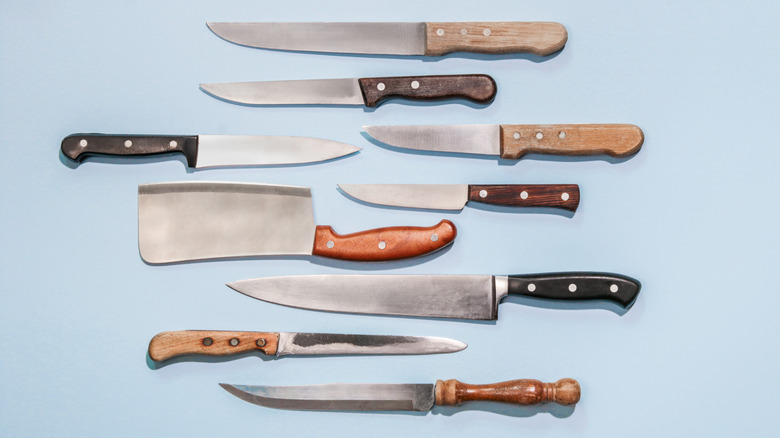What Are The Differences Between A Boning Knife And Cleaver?
Many people probably think that any knife can be used for any task. This is far from true: Every knife has a purpose, and choosing the right one for a specific job can help you prepare ingredients efficiently and safely. Anyone who enjoys cooking should have paring, serrated, and chef's knives to accomplish most tasks in the kitchen, but some cutting jobs require more precision and effort — two things that proper tools can make easier. Case in point: boning knives and cleavers.
The boning knife has a thin blade (even thinner than a slicing knife) that's usually about 6 inches long. The flexible version often curves upward like a cutlass and comes to a very fine point, following the contours of bone in poultry and fish. The stiff version, on the other hand, often has a straighter spine and is better constructed for cutting thick meats like pork and beef.
On the other end of the spectrum is the cleaver. This is a large, rectangular blade made of soft metal that's capable of withstanding hard chopping and heavy impact. It's kind of similar to a hatchet because its face is blunt and broad. Meanwhile, the spine can be either straight, concave, or convex. Since its effectiveness depends on how hard you swing it, it's important to learn how to use it properly — just as you should understand how to use a boning knife.
Precision cutting with a boning knife
The name of the boning knife might sound misleading at first, but you can clearly tell by looking at it that it doesn't actually cut through bone. Instead, this knife is primarily used to cut raw meat and fish away from the bone, which can be a delicate task. The blade's slender build allows it to glide along bone and separate the meat, minimizing food waste.
Whether you're using a flexible or stiff boning knife, hold the handle with three fingers and put your index finger on top of the spine — like it's an extension of your digit — for precision and control. Then, place the tip of the blade into the meat, creating a tiny incision, and drag the blade through the flesh. You can start using a sawing motion when you want to detach meat from the bone.
In addition to separating bones and meat, a boning knife can be useful for simply slicing meat into pieces. You can use it for carving skin off of fish and for slicing fruits and veggies, too. These numerous uses are why it's one of the knives experts say dedicated home chefs need in their kitchen.
Chopping (and more) with a cleaver
While a chef's knife is a popular choice for its versatility, a cleaver can accomplish all the same tasks and then some. The main purpose of this heavy cutlery is to chop through bones that other knives just can't handle. Even though butchers and restaurant chefs are more likely to use it, avid home cooks may find that it's sometimes worth splurging on good kitchen knives like this one.
Using a cleaver might seem dangerous, but anyone can get the hang of it with practice and by following some tips. For starters, you want to keep your free hand at a safe distance from the blade at all times, holding the meat (if you must) with your fingertips bent inward. While firmly holding the knife's handle and slightly bending your elbow, allow the cleaver's weight to do most of the work as you cut downward, flicking your wrist only slightly.
Using this knife is one of the best ways to chop brisket because it will make quick work of turning the meat into chunks. That said, a cleaver can also be used to filet, scoop, slice, smash, and mince ingredients, as well as tenderize meat with the blade's spine.


